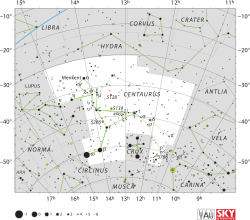Eta Centauri

| |
| Observation data Epoch J2000.0 Equinox J2000.0 | |
|---|---|
| Constellation | Centaurus |
| Right ascension | 14h 35m 30.42416s[1] |
| Declination | −42° 09′ 28.1708″[1] |
| Apparent magnitude (V) | +2.35[2] |
| Characteristics | |
| Spectral type | B1.5 Vne[3] |
| U−B color index | −0.862[2] |
| B−V color index | −0.215[2] |
| Variable type | Gamma Cas |
| Astrometry | |
| Radial velocity (Rv) | –0.2[4] km/s |
| Proper motion (μ) | RA: −34.73[1] mas/yr Dec.: −32.72[1] mas/yr |
| Parallax (π) | 10.67 ± 0.21[1] mas |
| Distance | 306 ± 6 ly (94 ± 2 pc) |
| Details | |
| Mass | 12.0 ± 0.3[5] M☉ |
| Radius | 5-6 R☉ |
| Luminosity | 8,700[3] L☉ |
| Surface gravity (log g) | 3.20[6] cgs |
| Temperature | 25,700[3] K |
| Rotational velocity (v sin i) | 330[3] km/s |
| Age | 5.6 ± 1.0[5] Myr |
| Other designations | |
| Database references | |
| SIMBAD | data |
Eta Centauri (η Cen, η Centauri) is a star in the southern constellation of Centaurus. It has an apparent visual magnitude of +2.35[2] and is located at a distance of around 306 light-years (94 parsecs).[1] In traditional Chinese astronomy, Eta Centauri was known as 庫樓二[8] (meaning: the Second (Star) of Koo Low).[9]
The stellar classification of this star is B1.5 Vne,[3] indicating that it is a B-type main sequence star. The 'n' suffix means that the absorption lines are broadened from rapid rotation. It has a projected rotational velocity of 330 km s−1[3] and completes a full rotation in less than a day. This is a Be star as shown by the 'e' suffix,[10] which means it has variable emissions in its hydrogen spectral lines. This emission can be modeled by a decretion disk of gas that has been ejected from the star and now follows a near Keplerian orbit around the central body.[11] Finally it is slightly variable, and classified as a Gamma Cassiopeiae variable star with multiple periods of variability.
Eta Centauri has about 12[5] times the mass of the Sun, placing it above the dividing line between stars that evolve into white dwarfs and those that turn into supernovae. It is radiating 8,700[3] times as much luminosity as the Sun from its outer atmosphere at an effective temperature of 25,700 K.[3] This heat causes the star to glow with the blue-white hue common to B-type stars.[12] Eta Centauri is a proper motion member of the Upper-Centaurus Lupus sub-group in the Scorpius-Centaurus OB association, the nearest such co-moving association of massive stars to the Sun.[6]
See also
References
- ↑ 1.0 1.1 1.2 1.3 1.4 1.5 van Leeuwen, F. (November 2007). "Validation of the new Hipparcos reduction". Astronomy and Astrophysics 474 (2): 653–664. arXiv:0708.1752. Bibcode:2007A&A...474..653V. doi:10.1051/0004-6361:20078357.
- ↑ 2.0 2.1 2.2 2.3 Gutierrez-Moreno, Adelina; Moreno, Hugo (June 1968), "A photometric investigation of the Scorpio-Centaurus association", Astrophysical Journal Supplement 15: 459, Bibcode:1968ApJS...15..459G, doi:10.1086/190168
- ↑ 3.0 3.1 3.2 3.3 3.4 3.5 3.6 3.7 Balona, L. A.; Dziembowski, W. A. (October 1999), "Excitation and visibility of high-degree modes in stars", Monthly Notices of the Royal Astronomical Society 309 (1): 221–232, Bibcode:1999MNRAS.309..221B, doi:10.1046/j.1365-8711.1999.02821.x
- ↑ Wielen, R. et al. (1999), Sixth Catalogue of Fundamental Stars (FK6). Part I. Basic fundamental stars with direct solutions (35), Astronomisches Rechen-Institut Heidelberg, Bibcode:1999VeARI..35....1W
- ↑ 5.0 5.1 5.2 Tetzlaff, N.; Neuhäuser, R.; Hohle, M. M. (January 2011), "A catalogue of young runaway Hipparcos stars within 3 kpc from the Sun", Monthly Notices of the Royal Astronomical Society 410 (1): 190–200, arXiv:1007.4883, Bibcode:2011MNRAS.410..190T, doi:10.1111/j.1365-2966.2010.17434.x
- ↑ 6.0 6.1 de Geus, E. J.; de Zeeuw, P. T.; Lub, J. (June 1989), "Physical parameters of stars in the Scorpio-Centaurus OB association", Astronomy and Astrophysics 216 (1-2): 44–61, Bibcode:1989A&A...216...44D
- ↑ "eta Cen -- Be Star", SIMBAD Astronomical Object Database (Centre de Données astronomiques de Strasbourg), retrieved 2012-03-03
- ↑ (Chinese) 中國星座神話, written by 陳久金. Published by 台灣書房出版有限公司, 2005, ISBN 978-986-7332-25-7.
- ↑ Allen, R. H. (1963), Star Names: Their Lore and Meaning (Reprint ed.), New York, NY: Dover Publications Inc., p. 154, ISBN 0-486-21079-0
- ↑ Janot-Pacheco, E., Leister NV et al. (1999), "Multi-periodicity of the Be star η Centauri from spectroscopic and photometric observations", A&AS 137 (3): 407, Bibcode:1999A&AS..137..407J, doi:10.1051/aas:1999256
- ↑ Silaj, J.; Jones, C. E.; Tycner, C.; Sigut, T. A. A.; Smith, A. D. (March 2010), "A Systematic Study of Hα Profiles of Be Stars", The Astrophysical Journal Supplement 187 (1): 228–250, Bibcode:2010ApJS..187..228S, doi:10.1088/0067-0049/187/1/228
- ↑ "The Colour of Stars", Australia Telescope, Outreach and Education (Commonwealth Scientific and Industrial Research Organisation), December 21, 2004, retrieved 2012-01-16
External links
- Eta Centauri by Jim Kaler.
| ||||||||||||||||||||||||||||||||||||||||||||||||||||||||||||||||||||||||||